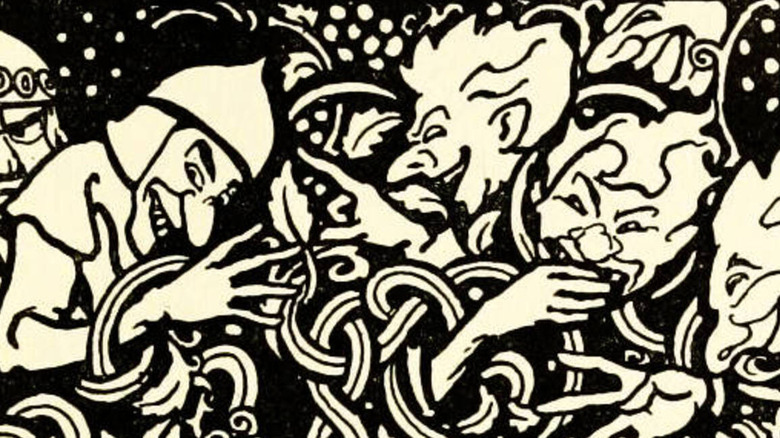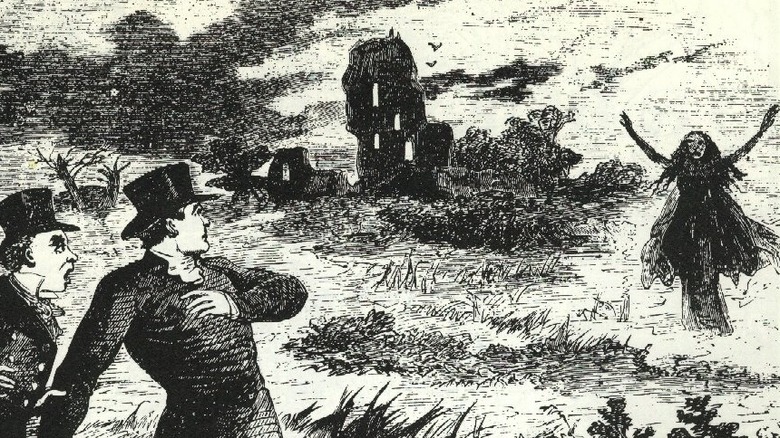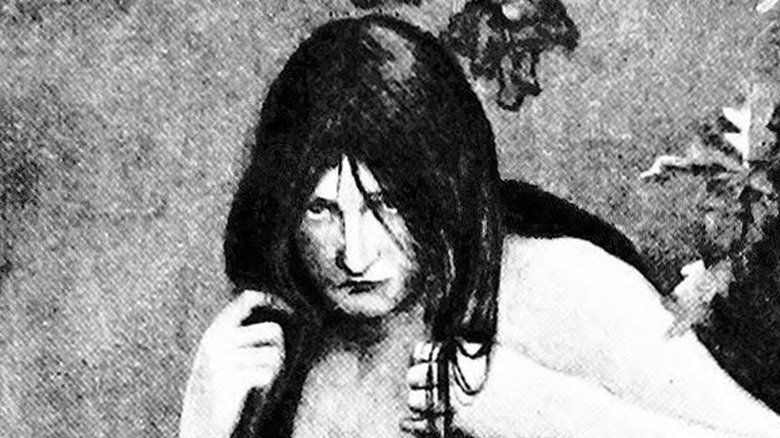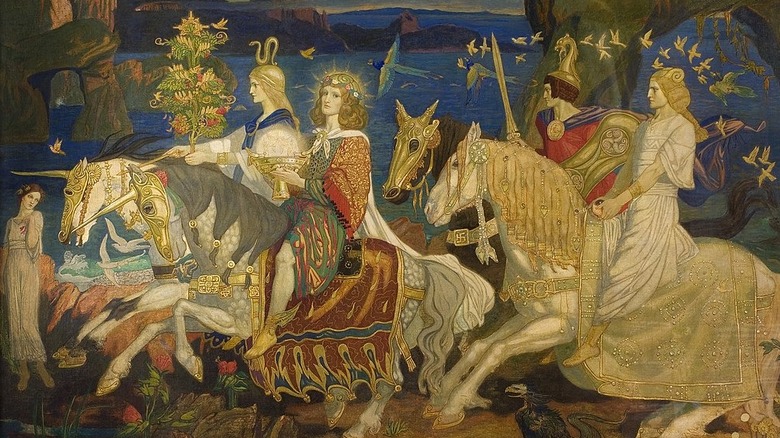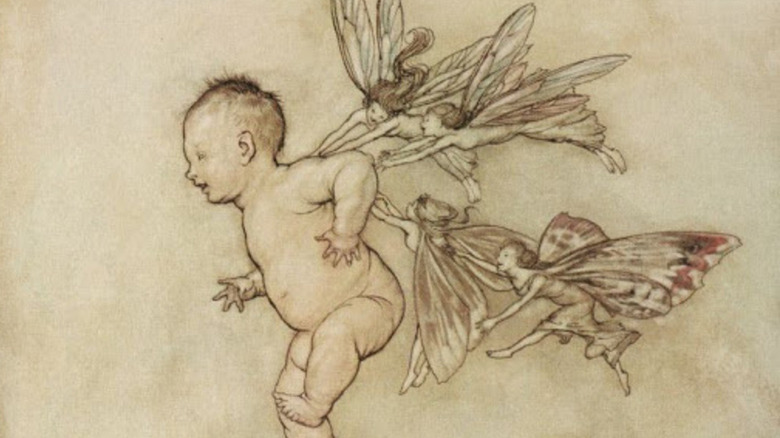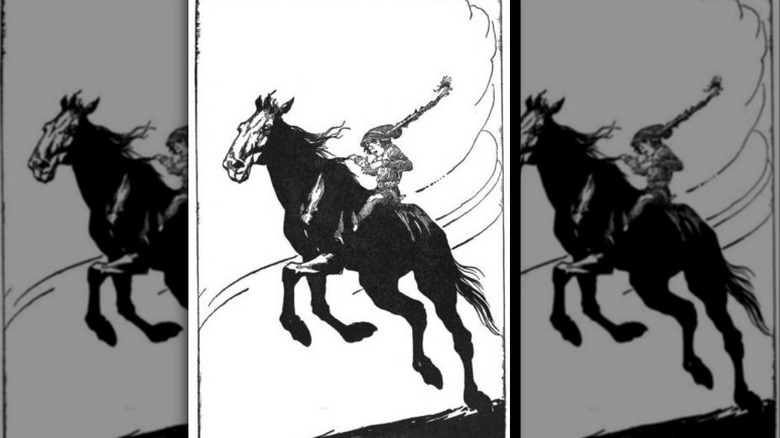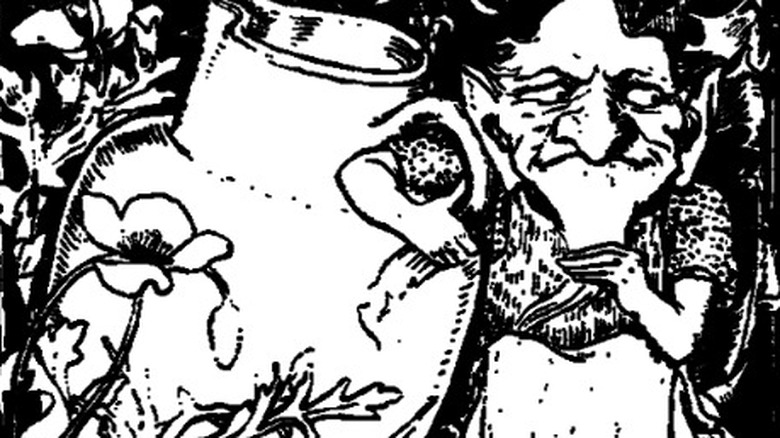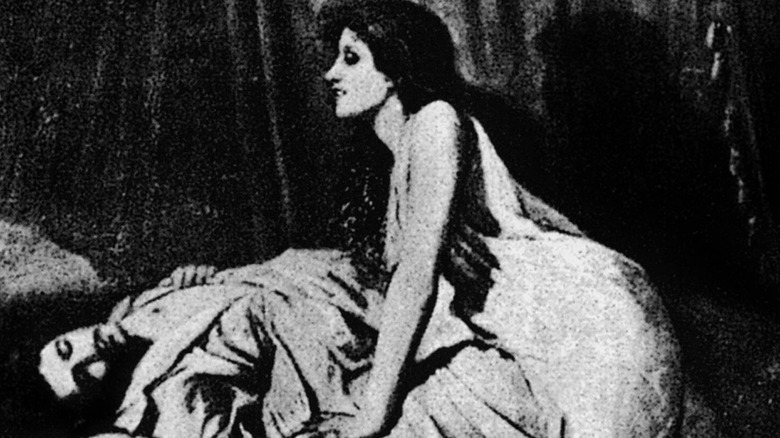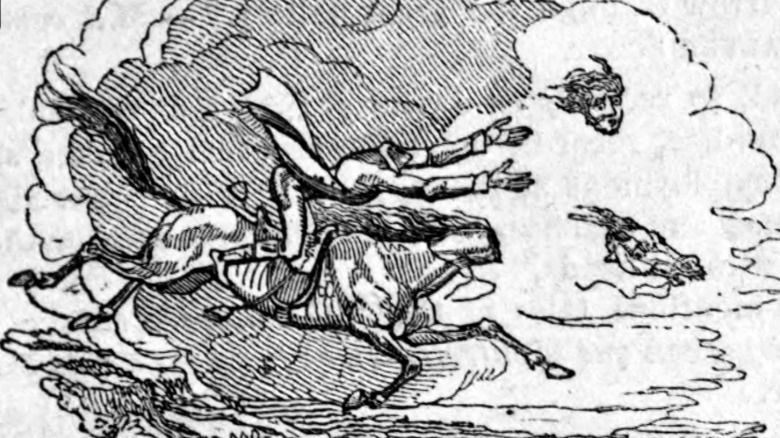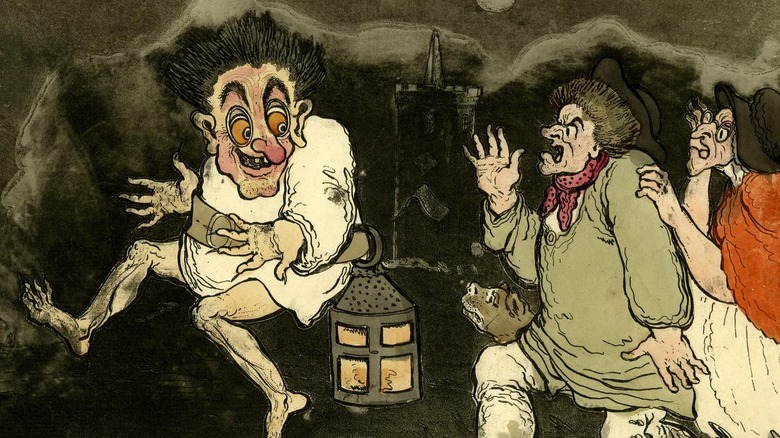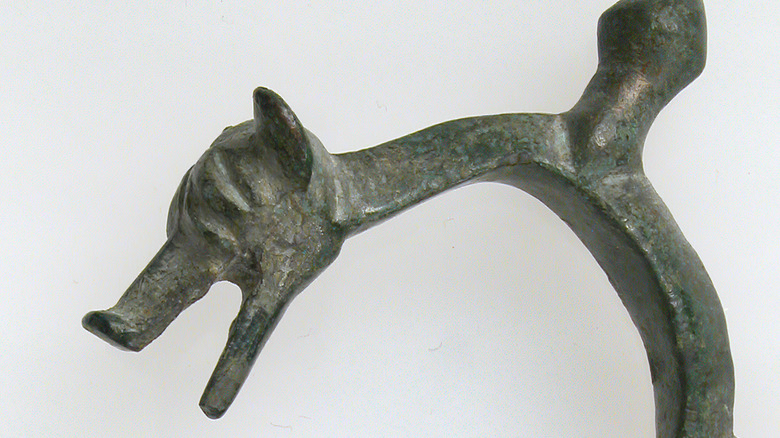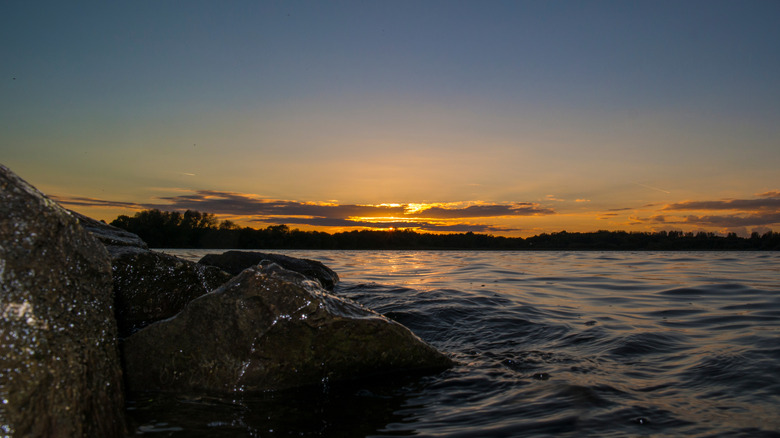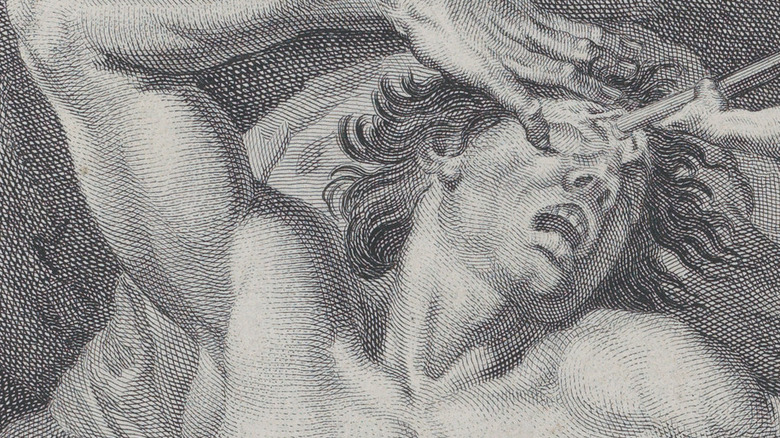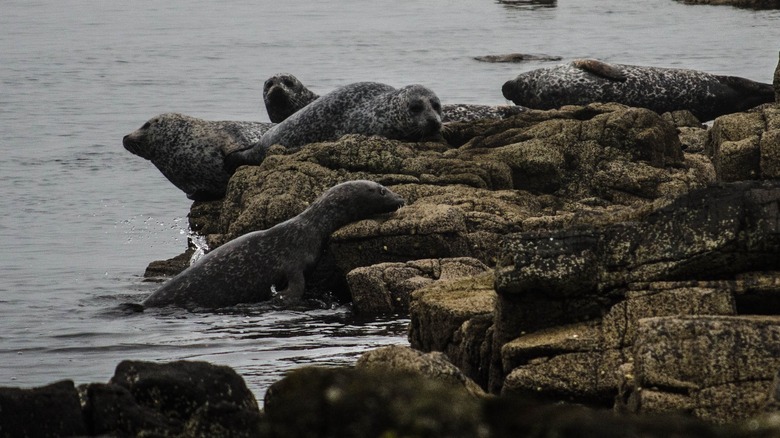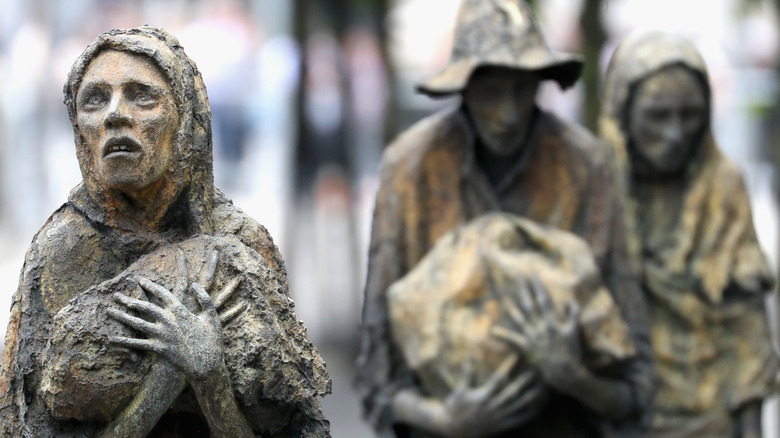The Strangest Creatures To Appear In Celtic Folklore
The mythology of the ancient people known as the Celts was full of heroic acts and mighty warriors –- but it's also filled with fascinating and sometimes terrifying creatures. As described by Britannica, in the fourth century B.C., the Celts lived throughout Europe, but after Julius Caesar took control of Gaul, the Celts were pushed back into the British Isles. Although changed by the introduction of Christianity, Celtic beliefs continue to thrive as the folklore of Ireland, Scotland, and Wales to this day.
Some of the strangest creatures in Celtic folklore, like the treasure-hoarding leprechaun, have become popular legends all over the world, as demonstrated by Irish Central. Others, like the one-eyed Balor or the ghastly Hungry Man are still largely unknown. Some, like the undead king Abhartach or the cursed Stingy Jack, may at first seem mysterious and bizarre, but as noted by The Irish Post and The Irish Times, they may actually be the original versions of some of the most well-known mythical stories and traditions in history.
Banshees
Banshees are one of the most famous beings featured in Celtic folklore, and one of the most frightening. They are best known as entities that scream mournfully in the night, terrifying anyone who hears them. Often, their wails are described as a bad omen; a sure sign that somebody is going to die.
As noted by Britannica, stories about banshees are told throughout Ireland and Scotland, and there are many different versions of the banshee legend. In some, they are described as a type of fairy and in others they are more like ghosts or spirits. As described in Elliot O'Donnell's book "The Banshee," banshees have alternately been described as "The Spirit of the Air" and "The Lady of Death." Whether she is warning the listener of an upcoming death in the family or actively causing the person who hears her cries to die also depends on the telling. Sometimes it seems as though people simply have the misfortune to hear a banshee's call overnight, but in some stories, the banshee is specifically targeting someone –- maybe even their descendants. Banshees have been described as plaguing a single family, causing bad luck and early deaths until the last member of the family line dies.
Kelpies and Merrows
In Celtic folklore, the creatures lurking under the water can be just as dangerous as those on land. Two of these are shapeshifters.
In Irish folklore, there is a creature called a merrow. As stated in "Fairy and Folk Tales of the Irish Peasantry," male merrows are described as frightening monsters with green hair and teeth. Female merrows, however, are described as gorgeous women with fish tails like mermaids. Sometimes, they take the shape of small cows to wander the shore.
In Scottish legends, even small rivers and streams can be home to deadly creatures. As described by Historic UK, the kelpie is a shapeshifting creature that can be found hunting in inland waterways. Their prey of choice: humans. Sometimes the kelpie is said to appear as a beautiful horse, but when children climb onto its back for a ride, its skin becomes too sticky to jump off of, and the kelpie carries them under the water. To attract adults, the creature is said to take the form of attractive women. Less refined kelpies may simply grab a person and drag them under.
The Fae
Fairies are among the most popular and beloved magical creatures in the world, but that doesn't make them any less strange. As described by PBS' "Monstrum," in Irish folklore, the fae are the descendants of a race of god-like royal entities known as Tuatha dé Danann. Their folklore is complicated, and depicts their arrival in Ireland, their battle against other magical beings, and their rule over Ireland before the arrival of mortals. Unlike the tiny-winged fairies that are popular today, the Tuatha dé Danann often appear as elderly humans with yellow skin. Since losing a conflict against human beings, they are said to live in an underworld, which they access through burial mounds.
The fae, also called Sidhe, are often depicted as malevolent or at least mischievous. With the rise of Christianity, legends about creatures which seemed like deities became controversial. Sometimes, they were depicted as demonic or as fallen angels. As stated by Irish Central, fairies are a fundamental part of Ireland's cultural history, and in the past, they were widely believed to be real.
Changelings
Fairies may be a beloved part of Celtic folklore, but many of their interactions with humans are genuinely disturbing. One of the strangest things that fairies are depicted as doing to people is stealing their children and replacing them with a fairy. As described by The Irish Post, these replacements are called changelings.
As detailed in K.E. Sullivan's "Scottish Myths and Legends," the fairies left behind other fairies disguised as human babies who didn't always play their parts well. In some stories they are described as speaking in complete sentences despite looking like infants. In other versions, they have slightly yellowed skin and eat enormous amounts of food. Sometimes, the fairy disguised as a human baby was actually an elderly fairy who would live out its life being cared for by the child's loving parents, while the actual infant was raised to serve the fairies.
Many changeling stories focus on the attempts of parents to force the fairies to return their children. In one story, the mother traps the changeling on a rock on the beach and threatens to let him drown if her own child is not returned. In another, excerpted from "Fairy Legends and Traditions of the South of Ireland" via University of Pittsburgh, a mother tricks the fairy into admitting it's 1500 years old and then threatens it with boiling water until he brings her baby back.
Pooka
Many creatures in Celtic folklore are tricksters, but few are so adept at causing chaos for humans as the pooka. As described by Atlas Obscura, the pooka is a shapeshifter and a trickster. It is often depicted as taking the form of an animal like a pig, goat, or dog –- typically a large black one. It also appears as a human, but those humans often have strange fur, ears, or even a tail which can give them away to people who pay close enough attention. In some versions of the legend, the pooka turns into an enormous monster made up of parts of different animals.
In other stories, the pooka forces unsuspecting travelers onto its back and carries them around all night, sometimes stranding them far from their homes. As described in "The Encyclopedia of Celtic Mythology and Folklore," pookas can sometimes be friendly and have been depicted helping with farm chores in exchange for clothes. Sometimes, however, it is a bad omen, and may cause severe physical illness to those who see it.
Leprechauns and Far Darrigs
Of all the creatures in Celtic folklore, the most closely associated with Ireland is certainly the leprechaun. The leprechaun is described as a type of fairy that hoards treasure. As described in the World History Encyclopedia, the majority of stories about leprechauns involve humans attempting to catch the leprechaun to force them to give up the location of their gold. These beloved creatures are associated with an older and more dangerous folklore creature: far darrig.
While the leprechaun is usually depicted as a little man wearing all green, the far darrig can change his size from tiny to very tall and wears all red. Like many other creatures in Celtic folklore, the far darrig is a trickster. It often plays tricks on humans for its own amusement, which sometimes results in injury or death for the creature's unfortunate target. As described in "The Encyclopedia of Celtic Mythology," one of the far darrig's favorite activities is to ask a human being to do something for him, and if they say no, he comes up with creative ways to punish them for their selfishness.
Abhartach and Dearg Due
There are terrifying vampire myths from all over the world, but some of the most influential come from ancient Celtic folklore. One vampire-like creature in Celtic folklore is the Dearg-Due. As described in the "Freeside Europe Online Academic Journal," Dearg-Due was also once a human being. According to the legend, she was a beautiful young woman who was forced by her father to marry a cruel man that she did not love. Her new husband made her life miserable, and is sometimes depicted as physically torturing her. She died, but returned from the grave to kill her husband and father.
As detailed in the "Encyclopedia of Fairies in World Folklore and Mythology," one of the most influential Celtic vampires is called Abhartach. According to the legend, Abhartach was a dwarf king who could do magic. He believed that his queen was having an affair, and fell to his death trying to peek in her window to witness it firsthand. His people buried his body, but the following night, he returned. The now-undead king forced his people to bleed into a bowl for him every night. Although a druid was able to eventually trap Abhartach in his grave, the vampire king was not killed, and according to legend, he can still attack anyone who walks over his grave. As noted by The Irish Post, it is believed that this story inspired Bram Stoker to write "Dracula."
Dullahan and Fetches
The banshee might be the most famous Celtic death omen, but it's far from the only one. One of the most unsettling is called a fetch. As described by Express, a fetch is an exact duplicate of a human being that appears around the time of their death. In various stories, people typically see and interact with a fetch, believing that it is their friend or loved one, only to realize later that the person they thought they were talking to was already dead.
The Dullahan is also a sign that death is coming, but he doesn't appear in as friendly a form as fetches do. As described in The Irish Times, The Dullahan carries his own rotting decapitated head under his arm. He and the banshee are often depicted riding in a black coach, pulled by two horses that are also headless. According to legend, the Dullahan shouts the names of people who are going to die and splashes blood into the faces of people who see him and his coach.
Stingy Jack and his hellish lantern
Many elements of the holiday we now know as Halloween can trace their roots back to Celtic traditions, including the Jack o' lantern. In fact, one of Celtic folklore's most unusual beings may be the original Jack.
As described by The Irish Times, the first things to be called Jack o' lanterns were a visual phenomenon that appeared as glowing lights over bogs and marshes at night. The character of Stingy Jack became popular in Irish folklore to explain what the mysterious lights were. It was believed that Jack had been an unpleasant man who worked as a blacksmith. He was able to outsmart The Devil himself and was given a magic lantern. Inside the lamp was a fire from Hell, which can never go out. Jack, often called Stingy Jack, was cursed to walk the Earth carrying his lantern.
There are earlier accounts of carved vegetables, but over time it seems that folklore evolved combining this tradition with stories about Stingy Jack. Early Jack o' lanterns are believed to have symbolized Jack's lantern lit by the fires of hell, but later it was believed that carved Jack o' lanterns could protect travelers from Stingy Jack.
Werewolves of Ossory
Stories about human beings who turned into wolves, or wolves that turned into human beings were widely believed in the Middle Ages. In fact, much of what we would call werewolf folklore was originally presented as fact. As described in Leslie A. Sconduto's "Metamorphoses of the Werewolf," stories about werewolves living in the old Irish kingdom Ossory were considered to be true historical fact.
As described in The Hollywood Reporter, in some Irish folklore people transformed into wolves in their sleep. As noted by The Irish Post, some stories describe these humans in wolf form as wolfwalkers, who could turn into wolves whenever they wanted to and lead wolf packs.
One version, which was widely considered true, stated that a man and a woman living in Ossory were cursed to leave their homes and transform into wolves once every seven years. If they survived their time as wolves, those two could go back to being ordinary humans, but in seven years another man and woman would have to transform.
Giants
Celtic folklore is famously populated by creatures that resemble little people like fairies and leprechauns, but it also contains many stories about enormous people, often known as giants. As described by Irish Central, these huge beings were often depicted as being so large that when they walked, they made the trees shake. In one story, a rock is thrown at a giant, and the crater left behind becomes Lough Neagh, Ireland's largest lake.
Some giants, like the Fomorians described in "The Irish Mythological Cycle and Celtic Mythology" are described as warlike and even demonic, but not all giants are unrelatable. As described in "The Encyclopedia of Celtic Mythology" some stories about giants are love stories. Gablach was a giantess who fell in love with a giant man called Lutur. A human man had already fallen in love with Gablach, however, and attempted to force her to marry him with an army, but Lutur and Gablach destroyed the humans, primarily by smashing them with a beam ripped out of a roof.
Balor and his evil eye
On Tory, an island off the coast of Ireland, there is a legend about a robber named Balor. As described by volume 3 of Studies in Celtic and French Literature, "Balor with the Evil Eye," Balor was famous for having a single eye in the middle of his forehead and another on the back of his head. The one on the back was the dangerous one. Anyone who looked at the eye in the back of Balor's head immediately died.
According to the most popular legend about Balor, he was given a prophecy that he would be murdered by his own grandson. When Balor's daughter had children, Balor drowned them to ensure he never had a grandson who could kill him. One escaped, however, and grew up to become a blacksmith named Lugh. He returned to Tory to seek revenge on Balor, and ultimately killed him by forcing a hot iron bar into Balor's evil eye. In some versions of the story, Balor's grandson is a cyclops.
Selkies
There are many magical creatures that can change their shape in Celtic folklore. One of the most fascinating is the selkie. As described by "The Lore of Scotland: A guide to Scottish Legends," selkies appear to be ordinary seals living in the ocean, but when they come on land, they slip off their seal skins, to reveal the bodies of beautiful women inside. When they have finished their business on land, they put their seal skins back on and return to the sea. If they cannot find their seal skins, however, they are trapped.
The best-known selkie legend tells the story of a human man who fell in love with a selkie, and stole her seal skin so that she couldn't return to the sea. Trapped on land, she was persuaded to marry the human man. They lived together for many years and had several children together. Finally, she discovered the place he had hidden her seal skin, slipped it back on, and immediately went back to the sea leaving her family behind. Her children were half-selkie, and it was believed that some people in Ireland and Scotland were still descended from selkies.
Hungry Man
One of the most disturbing ghosts in Celtic mythology is the Hungry Man, also known as the Fear Gorta. This legend is believed to have become popular after the 1840s famine in Ireland. As stated by the Embassy of Ireland, USA, roughly 1 million people were killed in the famine. The Hungry Man is a legend about a hunger so terrible that it outlives the person who starved to death.
The legend of the Hungry Man is related to legends about Hungry Grass. As explained in "The Encyclopedia of Celtic Mythology and Folklore," it was believed that there were patches of land which had been corrupted by famine, sometimes because a victim of the famine had been buried there. According to the legend, anyone who walked over this corrupted earth would die of starvation no matter how much they ate. Sometimes, this created a Hungry Man phantom.
The Fear Gorta is described as the unquiet spirits of people who starved to death during famines. In many stories, a Hungry Man waits by the side of the road to beg travelers for food. Those who appease the terrifying spirit with food or money are granted good luck.
